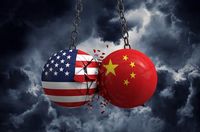On March 28, 2025, the U.S. government took a significant step in its ongoing trade tensions with China by imposing new restrictions on the export of computer technology. This move includes adding 80 organizations to an export blacklist, with more than 50 of those located in China, Iran, Taiwan, Pakistan, South Africa, and the United Arab Emirates. The Bureau of Industry and Security (BIS) stated that these restrictions are aimed at companies that "endanger national security," a justification that has drawn criticism from several quarters.
Among the companies targeted is Inspur Group, a major Chinese cloud computing firm and an AI research institution. Inspur has publicly condemned the decision, labeling it as unjust. The Chinese Ministry of Foreign Affairs echoed this sentiment, arguing that the U.S. action constitutes a violation of international regulations.
In response to these developments, U.S. Secretary of Commerce for Industry and Security, Jeffrey Kessler, emphasized the administration's firm stance, stating, "American technology may never be used against the American people." This reflects a broader trend in U.S. policy under the current administration, which has seen increased scrutiny and regulation of technology exports to China, particularly in sectors deemed sensitive or critical to national security.
The implications of these restrictions extend beyond the immediate targets. As tensions rise, the U.S. is also contemplating imposing a 100 percent import levy on chips manufactured in TSMC factories, a move that could have far-reaching effects on the tech industry.
Meanwhile, the situation at the port of Ghent contrasts sharply with the pressures faced by the port of Antwerp, which has been grappling with increased container traffic due to tariffs announced by the U.S. president. Companies are rushing to stockpile goods in the U.S. market ahead of these tariffs, leading to a significant imbalance in trade numbers. For the first two months of the year, the port of Ghent imported 750,000 tons of goods while exporting only 100,000 tons, marking a staggering 45% decrease in exports to the U.S.
Johan Bresseleers, a spokesperson for North Sea Port, noted that the dynamics of trade are shifting. He explained, "We import much more from the U.S. than we export, which is atypical. Many steel and aluminum companies are now hesitant to export to the U.S. and are exploring other markets, although they are not disclosing which ones." This sentiment reflects a growing trend among European companies to seek alternative markets amid rising costs and tariffs.
Economist Koen Schoors from the University of Ghent provided insights into this evolving landscape, suggesting that the trade industry is undergoing a regionalization process. "We are likely to see more trade within and around the European Union, resulting in a decrease in global trade overall," he stated. This shift could significantly alter the way businesses approach international markets.
However, the impact of U.S. import tariffs varies depending on the type of product. For instance, products that are easy to store and are facing a price increase of 20 to 25 percent in the U.S. are being shipped in large quantities now. Schoors explained, "If you sell beer that can be stored well, and it’s going to be more expensive in the U.S., you’d want to ship as much as possible now to maximize profits. But for products that don’t have a long shelf life or lower profit margins, companies are looking for alternatives."
This nuanced view of trade dynamics underscores the complexity of the current economic climate. As companies adjust their strategies in response to tariffs and market pressures, the long-term effects on production and trade routes remain to be seen.
Notably, the new import levies from the U.S. are unlikely to significantly impact the production of Volvo's new EX30 model at its plant in Ghent, according to Schoors. This indicates that while some sectors may struggle, others are finding ways to adapt and thrive despite the challenges posed by international trade policies.
As the U.S. continues to assert its position as a leader in artificial intelligence and technology, Vice President J.D. Vance has stated that Europe must align with U.S. standards in this sector. His comments reflect an ongoing push to maintain American dominance in technology and innovation, even as global trade relationships evolve.
In conclusion, the recent restrictions on technology exports to China and the shifting trade dynamics at ports across Europe highlight the complexities of international trade in 2025. With companies reevaluating their strategies and the U.S. government taking a hardline approach to national security, the landscape of global commerce is in a state of flux. As businesses navigate these changes, the future of trade will depend on their ability to adapt to new realities and find opportunities in emerging markets.


